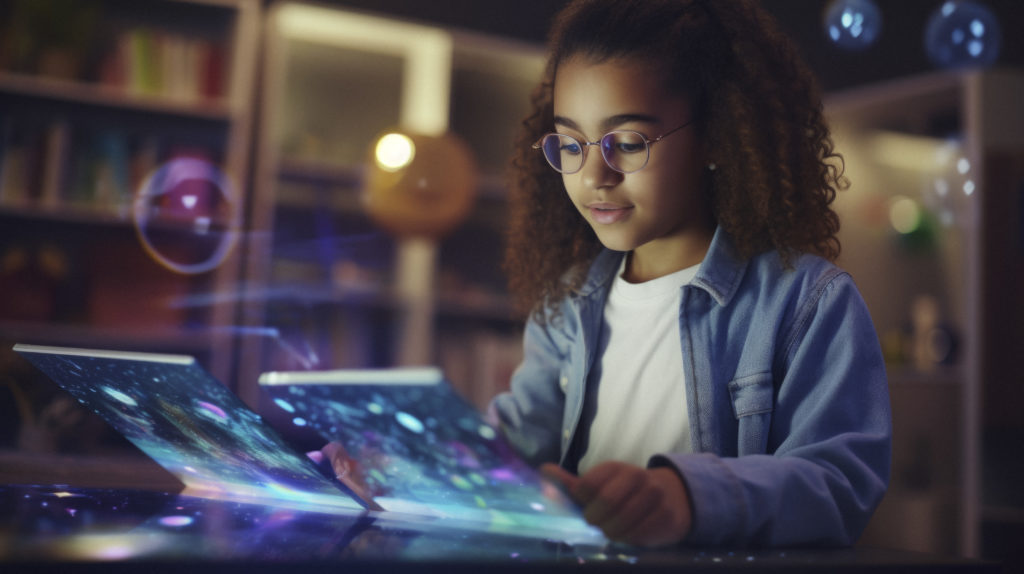Artificial intelligence (AI) has entered education in a big way and changed the way children (and adults) create, read and understand information. Platforms such as chatbots, translators, or “intelligent” image-generating machines have already become part of our everyday lives. But what does this mean for the way we learn? And what does it mean to be “literate” in the age of AI?
New Approach to Digital Literacies
Today, education experts do not talk about literacy only as reading and writing. Instead, they see it as something much more complex: a social, cultural, and digital practice that involves the body, emotions, technology, and interaction with others.
This means that when a child makes a digital comic using an AI tool, they are not just “using” technology. It is participating in a process of creating meaning – that is, it is trying to express itself, to make sense of the world, to connect with others.
AI as a “Partner” – Not just a Tool
AI tools don’t work passively. Instead, they generate ideas, influence our choices, and suggest words or images. This means that AI actively participates in the creation of meaning. This is why many researchers now speak of AI as a “co-author”—not just an assistant.
This has implications:
- Whose voice is that?
- Which ideas come first?
- What data does the machine “learn” and from whom?
Why Ethics is Important
Not all AIs are the same and do not always work “fairly”. Many studies have shown that algorithms may reinforce uniqueness, predict different linguistic or cultural realities, or even indirectly reinforce stereotypes. This is why it is important to acquire not only “skills in using AI”, but also a critical understanding:
- Who made this tool?
- How does it work?
- What does it exclude or ignore?
Children and Teachers in Digital Reality
Today, even in pre-school, children are getting in touch with AI. Games, educational apps and even digital assistants like Alexa are already used in classrooms. Researchers say children can learn basic ideas around AI – e.g. what it means “a program learns from examples”.
The question is how to design these experiences in a creative, safe, and critical way and how teachers will be supported to understand and integrate such technologies without fear or confusion.
What We Can Hold
AI opens up new possibilities for learning, but it also brings challenges. Rather than rejecting or accepting it uncritically, we need a balanced approach:
- Understanding how it works,
- Discuss its implications,
- And create new ways of literacy where humans and machines work together responsibly.
References
Bhatt, I. (2023). Literacies and the digital university: Critical perspectives and contemporary practices. Routledge.
Bhatt, I., & de Roock, R. (2013). Capturing the sociomateriality of digital literacy events. Research in Learning Technology, 21(0). https://doi.org/10.3402/rlt.v21i0.21281
Burnett, C., & Merchant, G. (2020). Undoing the digital: Sociomaterialism and literacy education. Routledge.
Burnett, C., Merchant, G., Simpson, A., & Walsh, M. (2014). Making New Literacies Research in Classrooms: Digital Literacies and Children’s Learning. English Teaching: Practice & Critique, 13(1), 5–20.
Burnett, C., & Merchant, G. (2016). Literacy-as-event: Accounting for relationality in literacy research. Journal of Literacy Research, 48(3), 297–317. https://doi.org/10.1177/1086296X16665383
Hawley, R. (2022). Towards reflective entanglements in the use of AI in education. In Postdigital Science and Education, 4, 362–381. https://doi.org/10.1007/s42438-021-00283-2
Jandrić, P., & Ford, D. R. (Eds.). (2022). Postdigital ecopedagogies: Genealogies, contradictions, and possibilities. Springer.
Knox, J. (2019). What does the ‘postdigital’ mean for education? Three critical perspectives on the digital, with implications for educational research and practice. Postdigital Science and Education, 1, 357–370. https://doi.org/10.1007/s42438-019-00045-y
Lankshear, C., & Knobel, M. (2011). New literacies: Everyday practices and social learning (3rd ed.). Open University Press.
Nichols, S. (2022). Old and new literacies: Assembling meaning in a timespace of change. In J. Rowsell & K. Pahl (Eds.), The Routledge handbook of literacy studies (pp. 203–213). Routledge.
Selwyn, N. (2022). Should robots replace teachers? AI and the future of education. Polity Press.
Bhatt, I., de Roock, R., & Adams, J. (2024). Literacy and AI: Postdigital perspectives on co-authorship and educational authorship. Postdigital Science and Education, 6(1), 21–40.

